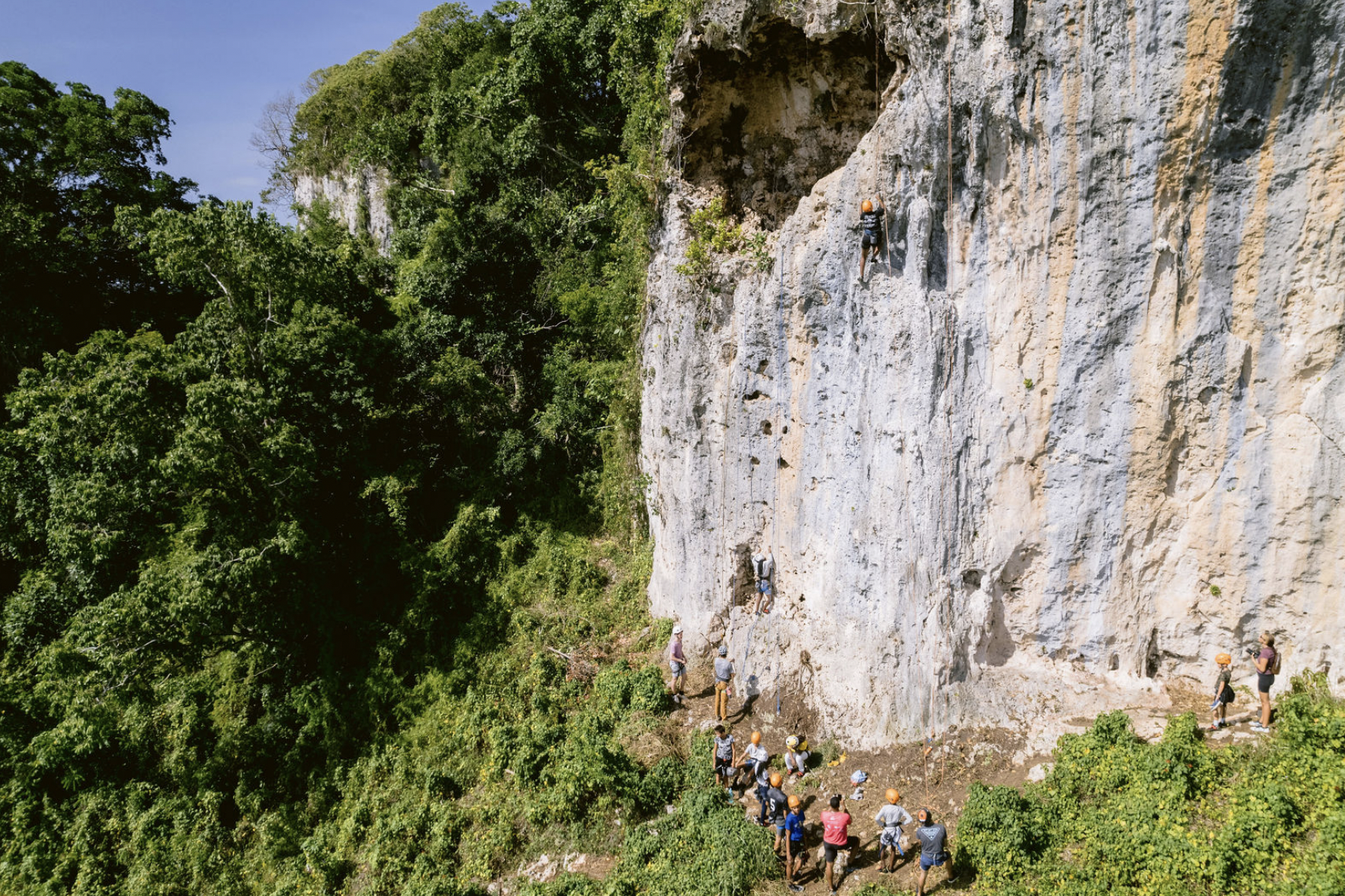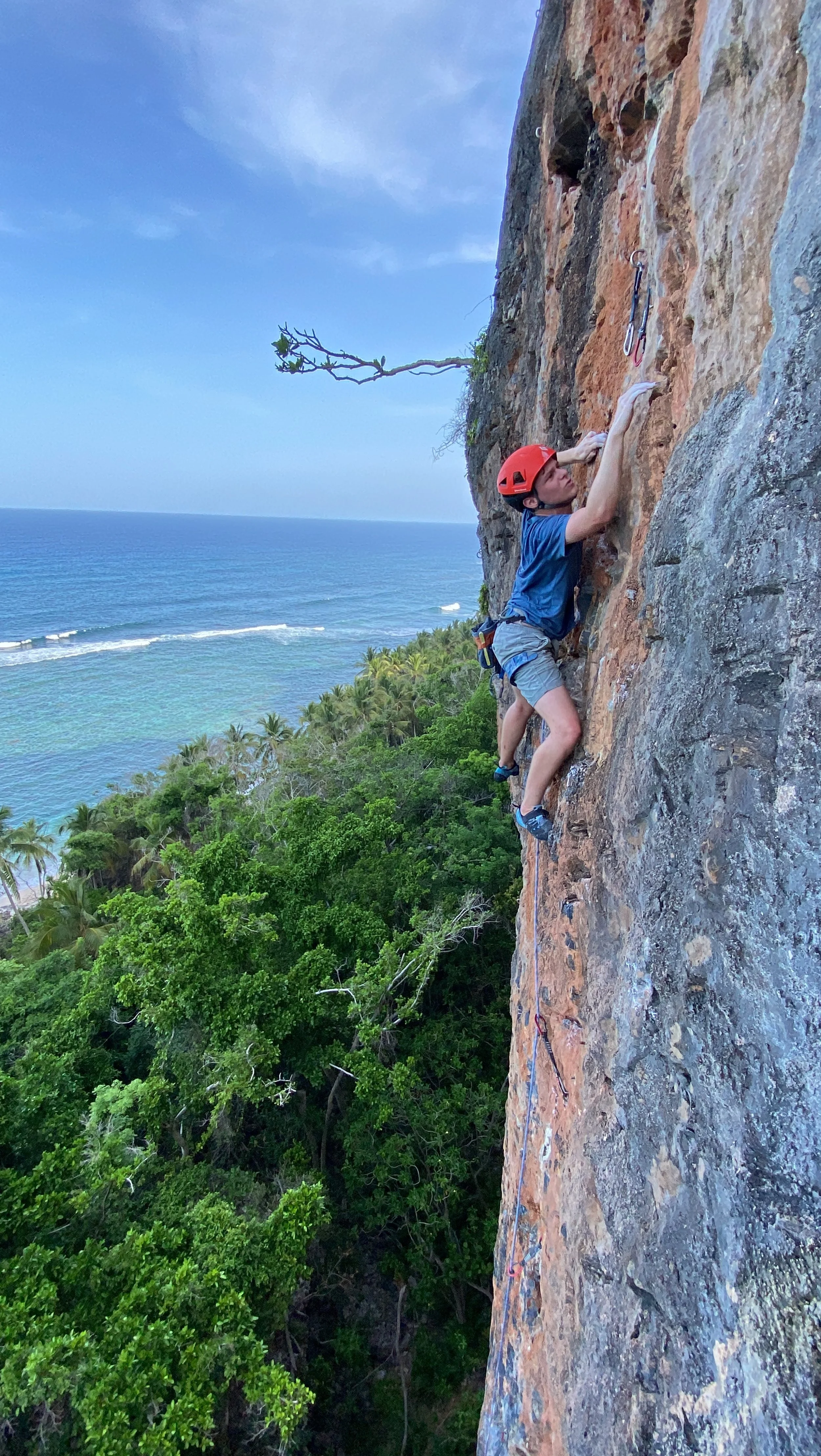
BACKGROUND
CONTEXTO
CONTEXTO DEL PROYECTO
En 2022, estaba buscando lugares para escalar en la República Dominicana. No pude encontrar nada dentro del viaje de tres horas entre Río San Juan y Cabrera. Los pocos lugares empernados que encontré estaban repletos de pernos más oxidados que mi español (afortunadamente, gente como Rudolf han trabajado duro para reemplazar la mayoría de estos). La falta de rutas seguras y accesibles fue sorprendente. He visitado RD toda mi vida y, en cada visita, he pasado acantilados bellos perfectos para escalar. En los últimos meses, había estado viendo videos de YouTube de personas empernando acantilados, y se me ocurrió que yo podía hacerlo aquí. Fuí a uno de los acantilados y evalué la roca para ver si valía la pena equiparlo. ¡La fricción era increíble! Era como si pudieras golpear tu mano a la parte más lisa de la pared y se pegara. Volví dos meses después y exploré el acantilado con mi amigo Ram. Caminamos a lo largo de la pared hasta llegar a una fisura que reveló una caverna; entramos a explorar. La caverna se abrió hacia un anfiteatro. Resultó ser una antigua cueva colapsada con 360 grados de roca sobresaliente. Sólo estaba a una caminata de 5 minutos desde el coche y me sentí como en una revista de National Geographic. Ese invierno, entré en contacto con Rudolf, un guía de escalada local y desarrollador de rutas, e hicimos planes para equipar esos acantilados el próximo verano.
Para empernar las rutas, encontramos una manera de llegar a la cima del peñasco. Desde ahí, rapelamos hacia abajo con machetes y despejamos las viñas y ramas de la pared. Esto es un proceso extremadamente largo-en una pared, nuestro equipo de tres personas (Rudolf, mi primo Quinton, y yo) pasamos 18 horas limpiando. La limpieza también es el paso más aterrador del proceso. Las avispas y abejas aman armar sus colmenas dentro de hoyos en la roca para protegerse de la lluvia y los depredadores. Mientras limpiamos, es difícil detectar las colmenas hasta que hay un grupo de abejas enojadas viajando hacia tí. Quinton ha sido picado más de 30 veces en la cara y cabeza rapelando para limpiar una ruta. Después de despejar la pared, planeamos las líneas que queríamos empernar y empezamos a taladrar los hoyos para los pernos. Una vez que hemos taladrado los hoyos y nos gusta como se ve la línea, limpiamos extensivamente todos los hoyos (el polvo puede impedir que el pegamento se ligue con la roca y reduce la fuerza del perno a la mitad) y añadimos pegamento. 24 horas después, hay una nueva ruta.
-Rascal Kemble Curry
PROJECT BACKGROUND
In 2022, I was looking for places to rock climb in the Dominican Republic. I couldn't find anything within a three-hour drive orf Rio San Juan and Cabrera. The few bolted places I did find were filled with dangerous stainless steel bolts that are rustier than my Spanish (thankfully, people like Rudolf have worked hard to replace most of these). The lack of safe, accessible routes was surprising. I’d been coming to the DR my whole life, and on every visit, I passed beautiful limestone cliffs right outside Cabrera that seemed perfect for climbing. For months, I had been watching YouTube videos of people bolting, and it occurred to me that this was something I could do. I drove up to one of the cliffs and felt the rock to see if it was worth equipping. The friction was amazing! It felt like you could slap your hand on the blankest part of the wall, and it would stick. I returned two months later and explored the cliff with my friend Ram. We walked along the wall until we came upon a fissure that opened up into a cave; we went in to explore. The cave opened up into a stunning amphitheater. It turned out to be a collapsed cave with 360 degrees of wildly featured overhung rock. Just a 5-minute walk from the car, and I felt like I was in a national geographic magazine. That winter, I got in touch with Rudolf, a local climbing guide and route developer, and made plans to equip the cliffs next summer.
To bolt the routes, we find a way to hike to the top of the crag. From here, we rappel down with machetes and clean the vines and branches off the wall. This is extremely time-consuming – on one wall our team of 3 people (Rudolf, my cousin Quinton , and I) spent 18 hours cleaning. The cleaning is also the scariest step of the process. Bees and wasps love to build their hives inside holes in the rock to keep themselves dry in the rain and protected from predators. While cleaning, it can be difficult to spot the hives until there is a swarm of bees headed toward your face. Quinton got stung more than 30 times in the face and head while rappelling in to clean a route. After cleaning the wall, we planned out the lines we wanted to bolt and started drilling holes for the bolts. Once the holes are in and we like the way the line looks, we thoroughly clean all the holes (dust can keep the glue from bonding to the rock and cuts the strength of the bolt in half ) and add glue. 24 hours later, there is a new climb.
— Rascal Kemble Curry
HISTORIA DE LA REGIÓN
La especie primaria de roca en RD es piedra caliza. La piedra caliza es una roca sedimentaria, esencialmente una pila de cadáveres de 500 millones de años que cayó al suelo oceánico. Después de la muerte de pequeños animales marinos, sus conchas y esqueletos se apilan en el suelo oceánico. A través del tiempo, las capas de cadáveres se condensan, exprimiendo el agua, y se cristalizan en roca sólida. Esta roca es impulsada a la superficie gracias a una combinación de actividad volcánica y movimiento de placas tectónicas. Dado que la piedra caliza está hecha de calcio ( por los huesos y las conchas de animales), es una piedra increíblemente sensible al ácido. A través del tiempo, la lluvia, que es levemente ácida, (aumentando su acidez con la concentración de CO2 en el aire), daña la roca, creando pequeñas ranuras y hoyos que son perfectos para escalar.
REGION HISTORY
The primary species of rock in the DR is limestone. Limestone is a sedimentary rock, essentially a 500 million-year-old pile of corpses that drifted to the ocean floor. After small marine animals die, their shells and skeletons build up on the ocean floor. Over time, the layers of dead animals press down on each other, squeeze out the water, and recrystallize into solid rock. This rock is then pushed up to the surface through a combination of volcanic action and the movement of tectonic plates. Because limestone is made from calcium (from the bones and shells of dead animals), it is an incredibly sensitive acid. Over time, rain, which is weakly acidic (increasingly so as the concentration of CO2 in the air rises) eats away at the rock, creating pockets and tuffas that we now use to climb.
THE FUTURE
In the summer of 2024, in addition to running a longer and more consistent summer camp, we will be running clinics for adults, teaching them how to be self-sufficient climbers and belayers. We will also be raising money to donate gear, such as ropes and harnesses, to budding local climbers.
EL FUTURO
En el verano de 2024, además de llevar a cabo cursos más largos y consistentes, estaremos organizando clínicas para adultos, enseñándoles a ser escaladores independientes y aseguradores. También recaudamos fondos para donar equipo de escala, como cuerdas y arneses, a entusiastas escaladores locales.





